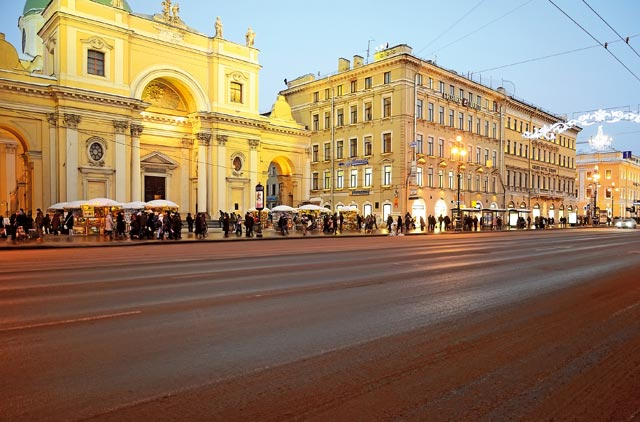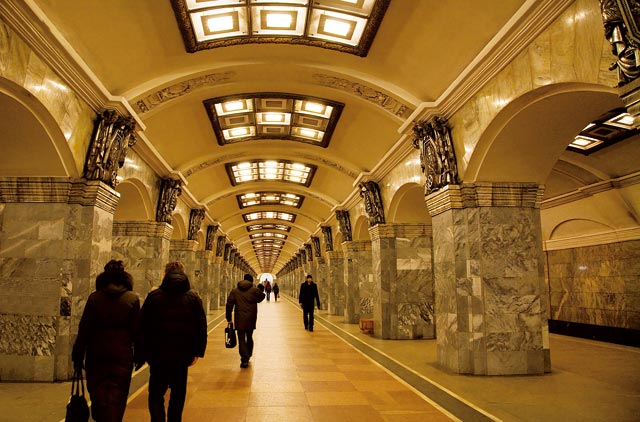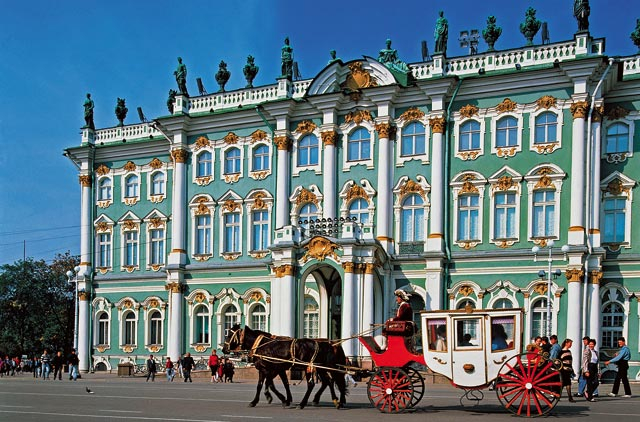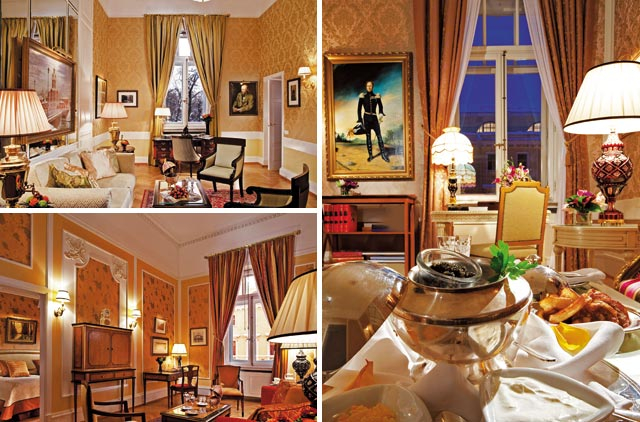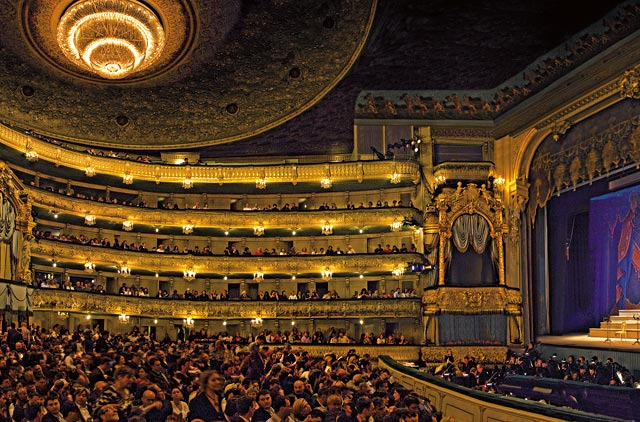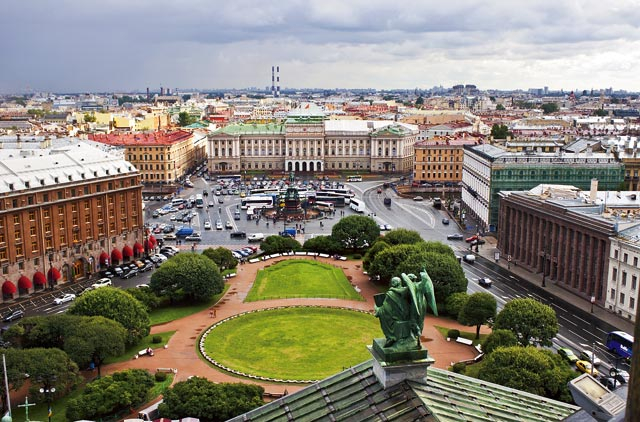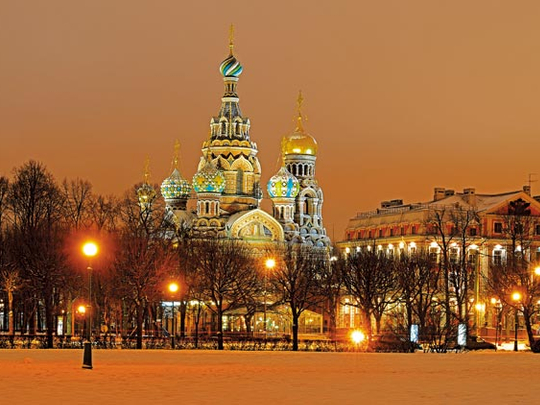
Is there anything more romantic than the dawn rising over just-fallen snow? Well, at 9am in a St Petersburg winter you wouldn’t know – the sun doesn’t stir his sleepy head until about an hour later, I discovered, peering out of my hotel window the first morning after we’d arrived in the Russian city. My stomach rumbled for breakfast as I watched the shadowy outlines of fur-clad commuters in the streetlamp-lit gloom, crunching through the frosty streets of the major shopping avenue, Nevsky Prospekt.
I couldn’t blame him – the sun that is – as I shuffled back down under the covers of the blissfully comfortable king-size bed, where I’d have happily remained ensconced until the early afternoon. My husband and I were in the Romanoff suite, named after Russia’s last royal dynasty, within the walls of one of the finest buildings from imperial St Petersburg, The Grand Hotel Europe. Looking down on us from all sides were stately paintings of tsars in full regalia, and it was easy to imagine this place in its heyday, buzzing with the chatter and demands of the country’s great thinkers, artists and royalty.
But, like all great love stories, Russia has a complicated past, with as many dark years as it has had golden. At breakfast in the palatial dining room, it was strange to survey the feast set out before us – pastries and fresh fruits, platter after platter of hot dishes, freshly cooked blinis glistening with caviar – and realise that this was the same room that served as a hospital during the 900-day siege by the Nazis, when an estimated 1.5 million died of starvation and people ate sawdust to stave off hunger pains.
I’d never been to Russia before and was ignorant of any history that didn’t make it into my Cold War GCSE module, so it came as a shock to understand the brutality that this city has witnessed. The story of the country is as compelling as any episode of Game of Thrones, with wives overthrowing husbands, sons murdering fathers, grim dictators and plotting soothsayers, all within the context of some of the world’s greatest literature, classical music and, of course, ballet.
“Russians love luxury,” said the Grand Hotel’s director of public relations, Irina Khlopova, as she took us on a tour of its magnificent historical floor. From the grandiose Amber suite – built in homage to the luminous room in Catherine Palace whose amber panels were disassembled and stolen by the Nazis and have never yet been found – to the finery of the Dostoyevsky suite – with a corner setting in tribute to the writer’s preference for a window with a view over ‘the crossroads of life’ – this certainly seemed to be true. And yet St Petersburg is a city that has assumed many personalities.
Built by Peter the Great in 1703, it was the capital of Russia until 1919. Tossed from lofty tsars to ruthless revolutionaries, it was Petrograd in 1914 when Russia went to war with Germany (the ‘burg’ sounded too Germanic); Leningrad in 1924 in tribute to the leader of the 1917 Communist revolution; and finally St Petersburg again in 1991 under the more liberal regime of President Mikhail Gorbachev.
So, while Russians might “love luxury”, there are whispers of the city’s more austere past in the bleak Soviet buildings that dot the urban blocks, in the bronze statue of Lenin outside Finland station in the St Petersburg suburbs, and in the likes of the Museum of the Defence and Siege of Leningrad – well worth a visit if you’re a history buff.
Woollies and walruses
But we were in the city for a romantic weekend, and the sumptuous baroque architecture and snowy treetops were more what we were after. Luckily there was a great dollop of this at the end of our hotel tour in one of the rooms on the top floor. Peering through the glass balcony doors – wedged shut by a foot of snow – we admired the stately facade of the Russian museum in the square below, making way for a magnificent view of the Church of the Saviour on Spilled Blood’s shiny onion domes, jam-packed with jewels and scattering shards of reflected light in the midday sun. Unlike the European-influenced architecture of the rest of the city, this church is in the ostentatious Russian Revival style, built as a memorial on cobblestones stained with the assassinated Tsar Alexander
II’s blood.
You won’t hear much about winters in Russia – holiday packages tout the summer months, specifically the 80 ‘white nights’ of St Petersburg, when an arts festival lures visitors from all over the world, restaurants are stuffed to the seams and the canals hum with tourist-filled boats savouring the 24-hour semi-light that this northern city can boast.
While I’ve always been drawn by the idea of the midnight sun, my husband is a winterphile and it was he who had convinced me to make the trip in January. This meant that the canals of this so-called Venice of the North were of course frozen over, to be enjoyed only by the ‘walruses’ – eccentric Russian men and women who cut holes in the ice for a bracing dip.
Accustomed to a balmy Dubai climate, it was certainly chilly – even my teeth seemed to feel cold. Underprepared in just a borrowed woollen coat, I needed some convincing to get into the spirit of it all. “Warm weather for Russia,” chuckled the hotel doorman at my meteorological complaints as we shivered out of the Grand Hotel’s lobby to brave the minus- ten-degree air.
We creaked our way over compact snow to the unmissable first port of call for any St Petersburg visitor, the State Hermitage museum.
A conglomeration of palaces, galleries outhouses and a theatre, it is bulging with world-class art and antiquities to such an extent that it’s said it would take anything from five to 18 years (depending on which literature you read) to appreciate the entirety of its contents. We were willing to give it an afternoon and – Rembrandts and Da Vincis aside – I had never seen anything like the treasures in the basement floor, where the mysterious remains of an ancient Siberian chieftain and a mummy known as the Ice Maiden lie along with various curios including the Pazyryk Carpet, which dates back to the 5th century BC.
Ballet and borscht
You can certainly have your fill of culture in St Petersburg and we made the most of it with an almost obligatory visit to the ballet in the evening. Ballet is not just a dance form in Russia – it is a fierce, beating national passion. During our visit the front page of the St Petersburg Times was carrying the story of the acid attack on Bolshoi theatre artistic director Sergei Filin – a dramatic example of the primal place that ballet holds in many Russian hearts.
The world-famous St Petersburg ballet house the Kirov, known as the Mariinsky in Russia, was showing something that sounded rather cutting-edge, so we opted for a more traditional-sounding rendition of Giselle at the less opulent Conservatoire just across the road. The most novel aspect for me was the atmosphere in the audience. Unlike the stuffiness I’d usually associate with ballet, this crowd was teaming with people from every walk of life – the very young and the very old.
Any cultured city has to have good places to eat, and we were pleasantly surprised by the cosmopolitan variety of cuisines on offer as we wandered the roads after the show, and also by the quality of Russian cooking.
I had no particular expectations but was impressed by the succulent stuffed dumplings, crisp kulebyaka (fish pie) and hearty borscht (soupy beef stew) that we sampled.
The next morning we set out again, this time using the metro system we’d heard so much about. Due to the city’s difficult geology and swampy subsoil, the St Petersburg Metro is one of the deepest subway systems in the world and many stations are renowned for their Soviet architecture and beautiful artwork.
Alighting at Sadovaya station, we skidded our way to the entrance of St Isaac’s cathedral to climb the stone spiral staircase to enjoy some of the best views of the city. It was bitter and blustery, but the panorama of imposing classical architecture, the black snake of the Neva river, grey frozen canals and Bruegel-like silhouettes of dark figures traversing the bleak landscape made for an unforgettable experience.
We rounded off our visit with a trip to Yusupov palace – a bombastic affair bursting with gilded paintings, marble statues and the cellar in which the notorious royal adviser Rasputin was murdered. Sadly the basement tours are run only in Russian and a translator wasn’t available at the time of our visit, but legend has it that he was enticed to the palace with the promise of a party, then was fed poisoned cakes – which had no effect – was shot three times and finally, in desperation, he was thrown into the river. His post mortem is said to have shown that he died solely from drowning.
Trudging back to the hotel on that final evening, it was easy to shake off the darker side of St Petersburg. Majestic and malevolent as the city’s rulers have been, I couldn’t help but feel there’s something magical in all this.
It’s a city where ballet is as popular as football, where the metro is a tourist attraction in itself, and where the closest thing to noise pollution we heard was Tchaikovsky being played at top volume from a beaten up old Lada.
Gingerly gliding our way over perilously icy, picturesque bridges, the pastel-coloured buildings twinkled with snowflakes like icing sugar on baroque ice creams. I had been looking for the romance in Russia and, as twilight fell and the street lamps cast a rosy glow before us, there it was. I’d fallen in love with a cold climate.


